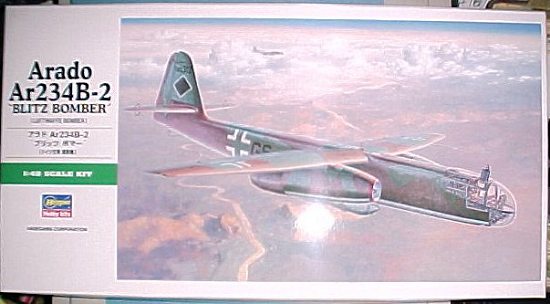
|
KIT: |
Hasegawa 1/48 Ar-234B-2 Blitz |
|
KIT # |
9083 (JT 83) |
|
PRICE: |
$39.98 MSRP |
|
DECALS: |
Three KG 76 aircraft |
|
REVIEWER: |
|
|
NOTES: |

|
HISTORY |
Arado Flugzeugwerke began initial work on a jet-powered photo-reconnaissance aircraft in 1940. The result was the Ar-234B-2, the world's first designed-for-the-purpose jet bomber to be flown operationally.
Because the fuselage needed to be used for fuel tanks and the wings were too thin to house conventional landing gear, the initial design used a wheeled dolly for takeoff which was dropped by parachute when airborne, with the airplane landing on retractable skids. The first prototype - which flew in the summer of 1943, used this system with no problems encountered. However, the Luftwaffe foresaw defense problems, with aircraft lying around the landing field awaiting a tow becoming targets for enemy strafing attacks. Arado was instructed to equip the airplane with conventional landing gear, regardless of the effect on range due to reduction in fuel capacity, since the landing gear would have to be completely housed in the fuselage. A benefit of this arrangement was that the airplane could now carry a bomb between the main gear, and the design was modified for dual use as a bomber and photo-reconnaissance aircraft.
By the spring of 1944, an initial trials unit had been established, and the Ar-234 was successfully flown on photo-recon missions over England before the invasion; at the speed and altitude it flew it, the airplane was effectively immune to interception by piston-engined interceptors. KG 76 became the operational home of the Ar-234 in the fall of 1944. Operating as a bomber, the Ar-234 was slowed sufficiently by the weight of ordnance that it could be intercepted by Allied fighters if it was spotted far enough away and they were in a position to dive on it. The Ar-234 saw its first operational use as a bomber during the German attempt to destroy the Ludendorff Bridge - the only bridge across the Rhine the Allies were able to capture intact in the spring of 1945. By the time the German attacks had the desired effect of weakening the bridge enough for it to fall, the American Army had built pontoon bridges and had pushed enough troops and equipment across the river so that loss of the bridge had no effect on the final defeat and occupation of Germany a month later.
|
THE KIT |
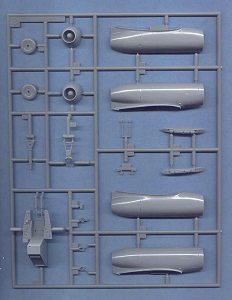 |
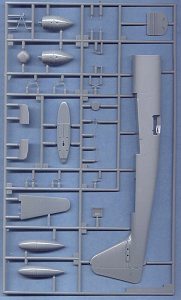 |
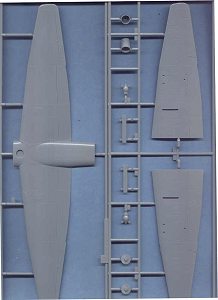 |
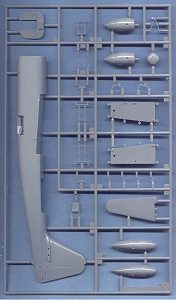 |
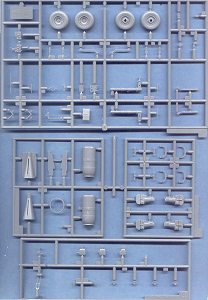 |
The only
previously-available kits of the Arado Ar-234 that I know of were a 1/72
offering from Lindberg in the 1960s, a Japanese resin "garage kit" in the mid
1980s, and an injection-molded kit from Hobbycraft in the late 1980s which was
unfortunately closer to 1/50 than 1/48 scale. (Your editor, who has more
useless knowledge than most, can add the Combat vacformed kit in 1/32, a Frog
kit in 1/72 and also in that scale, the very nice
Dragon/DML kit which comes in
many variants) Hasegawa has filled a big gap in the list of important
aircraft with the release of this kit. The model is the result of a co-venture
between Hasegawa and Revell of Germany that will see RoG release the Ar-234C
later this year, while Hasegawa will also release the night-fighter variant of
the Ar-234B this fall.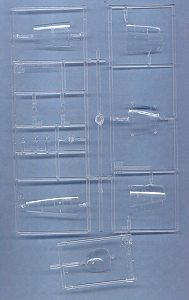
The model is crisply molded in the standard Hasegawa light grey plastic on eight sprues, with the entire nose molded in clear plastic in 5 parts, with the windows for the cameras a separate molding. This is the one place where the model has problems, and these problems are endemic to trying to injection mold clear plastic, which is not as easy as opaque plastic. There are two mold gates for each part, so that enough plastic can be injected to get the whole part without a short shot; unfortunately, this results in a "mold line" inside the plastic of each of the four main parts of the nose. I have heard from other modelers that one can sand down the area, polish it out, dip the part in Future, and the seam will be less noticeable. On the parts in this review copy, it does not seem possible to do anything with sanding. However, the "mold line" is really only visible when the parts sprue is held up to the light and one looks directly at the part; if viewed at any sort of angle (like it will be when completed), the "mold line" is not visible. I do plan on dipping these parts in Future, which should solve the problem as much as it can be. The nose cap does have a mold seam on the middle - this can indeed be dealt with by sanding it off, polishing the part, and dipping it in Future.
Another problem I have
been made aware of is a difficult attachment of the wing to the fuselage. There
appears to be a small ridge on the forward wall of the fuselage where the wing
attaches. Be sure to file that area so it is completely flat, and the
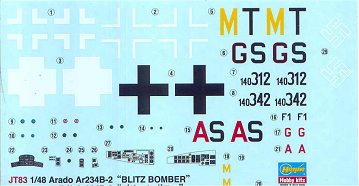 attachment should be easy. Also, there is a .010 gap between the fuselage and
the inner edge of the lower wing; this can be resolved by shimming with
Evergreen sheet. However, do not fill the gap between the inner edge of the
flap and the fuselage, since this was present on the real airplane.
attachment should be easy. Also, there is a .010 gap between the fuselage and
the inner edge of the lower wing; this can be resolved by shimming with
Evergreen sheet. However, do not fill the gap between the inner edge of the
flap and the fuselage, since this was present on the real airplane.
Past these items, there do not appear to be any other obvious surprises in the kit. The decals are thick, as is usual with Hasegawa kit decals - fortunately I purchased one of the Aeromaster Ar-234 sheets several years ago, and - while these were made for the slightly under-scale Hobbycraft kit - they will be far better than the kit decals, since they also include stenciling that is missing on the kit sheet.
|
CONCLUSIONS |
I have been in "I gotta have this!" mode since the kit was first announced earlier this year, and to me it appears that Hasegawa has provided the basis of a good-looking model. Yes, there's a bit of "modeling skill" required to deal with the fiddly bits, but isn't that what the hobby is about?
Thanks to HobbyLink Japan for providing the review copy.
If you would like your product reviewed fairly and quickly by a site that has well over 150,000 visitors a month, please contact me or see other details in the Note to Contributors.